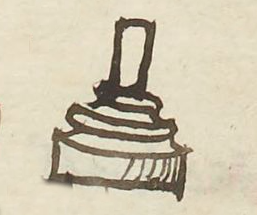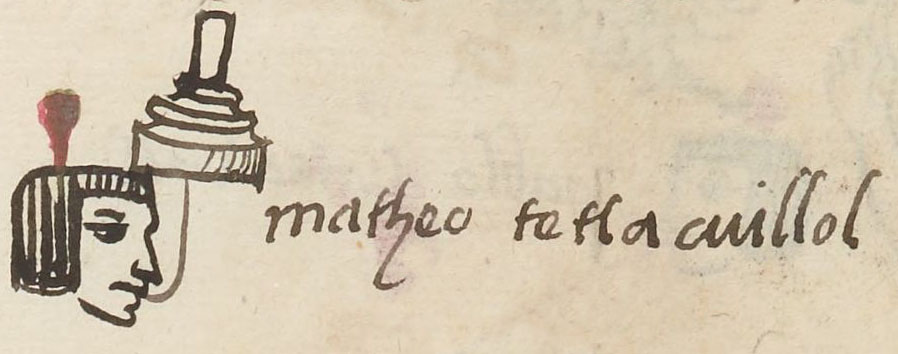Tetlacuilol (MH486v)
This simplex glyph for the personal name (or occupation) Tetlacuilol (perhaps "Carved Stone") shows the base of a European-style, round stone column. It seems to have five layers at the base, and then the column arises from there, but the column is short, just a suggestion. The column is also not very wide in proportion to the base. Nothing is painted or shaded.
Stephanie Wood
This type of architectural feature represents an introduction that came with colonialism. But there are various men in the Matrícula de Huexotzinco who seem to have learned the skill involved in carving these stones.
Interestingly, the use of "tetlacuilolli" (either a carved stone or a stone writing/painting/design) was applied to this architectural feature. A tlacuilolli could be a document, for instance, or a painting, but in this case it must refer to the design, the intense labor of working the stone (tetl).
Marc Thouvenot identifies the verb icuiloa (or ihcuiloa, with the glottal stop), which means to paint, write, or print, as having a root of -cuil-. He notes how it also appears in tlacuiloliztli (writing), tlacuilo (writer), and cuicuiltic (mottled). He goes on to show various uses of icuiloa that take it beyond the simple definitions just given, resulting in something like the action of creating a design (e.g., on leather, ceramics, sculpture, or in textiles). It can also be something like the action of decorating (e.g., to put a flower on a cup of atole). He associates icuiloa and tlacuilolli with "cultural artifacts," such as arts and crafts or examples of writing and painting, but cuicuiltic with effects created by "nature." This short summary barely does his article justice; it is worth reading the entire piece. How Thouvenot's study might connect with the concept of bent or curved mentioned by Prem (1974: 555, 682) raises an interesting question. Perhaps the bent or curved lines of writing, painting, carving, embroidery, and so on, fall with in the realm of expressions of -cuil-. See
Marc Thouvenot, "Imágenes y escritura entre los nahuas del inicio del XVI," Estudios de Cultural Náhuatl 41 (2010).
Stephanie Wood
matheo tetlacuillol
Matheo Tetlacuilol
Stephanie Wood
1560
Xitlali Torres and Stephanie Wood
stone, piedra, labrar, carve, tallar, designs, diseños

te(tl), stone, https://nahuatl.wired-humanities.org/content/tetl.
tlacuilol(li), a written or painted thing or a design, https://nahuatl.wired-humanities.org/content/tlacuilolli.
Piedra Labrada
Stephanie Wood
Matrícula de Huexotzinco, folio 486v, World Digital Library, https://www.loc.gov/resource/gdcwdl.wdl_15282/?sp=53&st=image.
This manuscript is hosted by the Library of Congress and the World Digital Library; used here with the Creative Commons, “Attribution-NonCommercial-ShareAlike 3.0 License” (CC-BY-NC-SAq 3.0).









